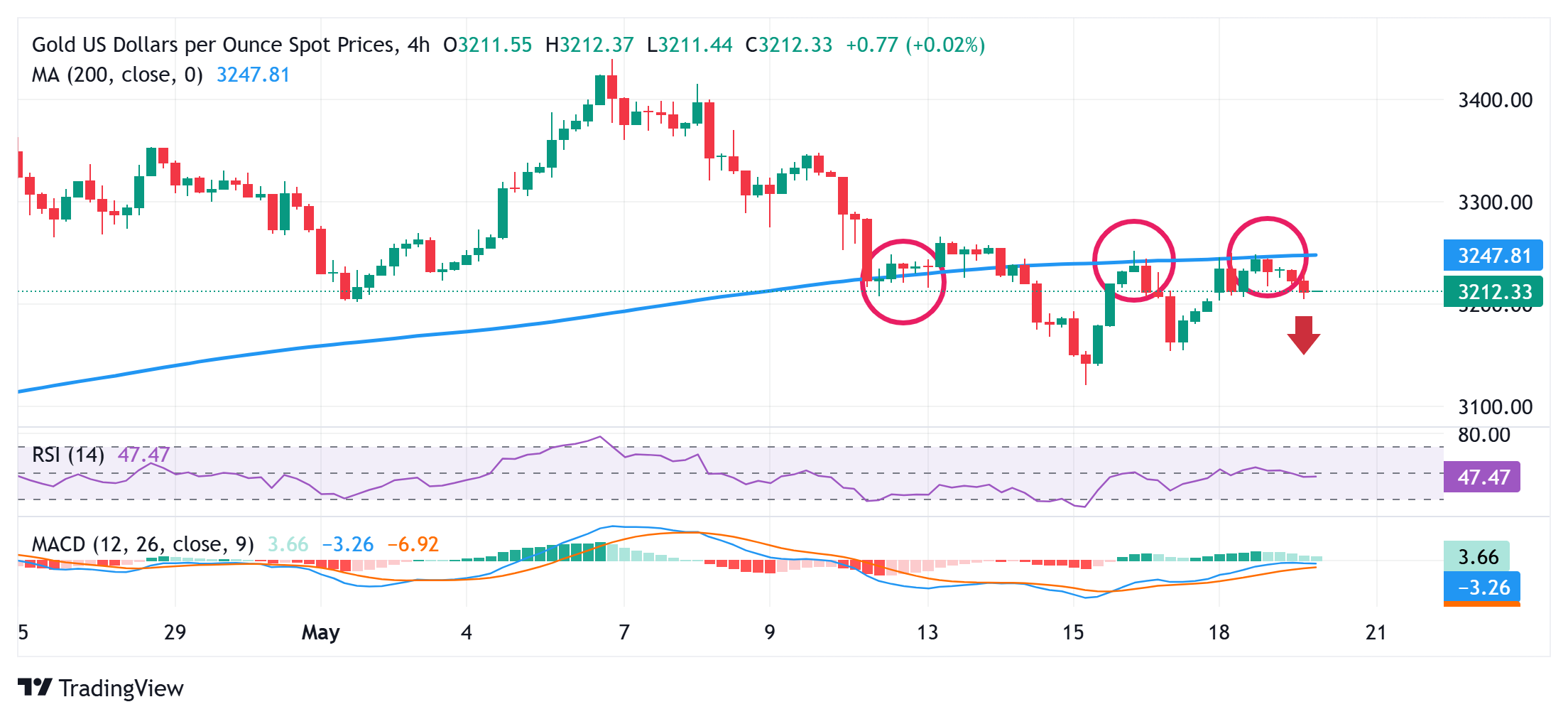- Gold price drifts lower as a positive risk tone continues to undermine safe-haven assets.
- The XAU/USD pair struggles to lure buyers despite Fed rate cut bets and a softer USD.
- The mixed fundamental backdrop, however, warrants some caution for bearish traders.
Gold price (XAU/USD) maintains its offered tone through the Asian session on Tuesday, though it manages to hold above the $3,200 round figure. Against the backdrop of rising trade optimism, hopes for a Russia-Ukraine ceasefire remain supportive of a positive risk tone. This is evident from a generally positive tone around the equity markets, which undermines demand for traditional safe-haven assets and exerts downward pressure on the bullion.
Meanwhile, the US Dollar (USD) continues with its struggle to attract any meaningful buyers amid the growing acceptance that the Federal Reserve (Fed) will lower borrowing costs further in 2025. This, in turn, is holding back traders from placing aggressive bearish bets around the non-yielding Gold price. Moreover, the range-bound price action witnessed over the past week or so warrants caution before positioning for any further depreciating move.
Daily Digest Market Movers: Gold price continues to be undermined by the upbeat market mood
- Moody’s downgraded America’s top sovereign credit rating by one notch, to “Aa1” on Friday, citing concerns about the nation’s growing debt pile. This, however, had a modest impact on the global risk sentiment amid rising trade optimism, which, in turn, failed to assist the safe-haven Gold price to capitalize on the previous day’s modest gains.
- Traders increased their bets on further interest rate cuts by the Federal Reserve in 2025 following the release of weak US inflation figures and Retail Sales data last week. In fact, the current market pricing indicates higher odds of at least two Fed reductions in 2025. This keeps the US Dollar depressed near a one-week low touched on Monday.
- On a more hawkish note, Atlanta Fed President Raphael Bostic said that inflation is not moving to target as fast as anticipated, and inflation expectations are moving in a troubling way. Bostic added that the number of rate cuts this year depends on how things turn out, and details of the tariffs will matter. Bostic leans toward only one rate cut this year.
- New York Fed President John Williams said that the recent economic data has been very good and that the labor market is pretty much in balance. Williams, however, warned that some forward-looking indicators are signaling concern. The key word for the economy is uncertainty, and the monetary policy is in a good place, Williams added further.
- Fed Vice Chairman Philip Jefferson noted that the US could face a one-time increase in the price level from tariffs, but needs to be sure that it does not become a sustained increase in inflation. It is too early to tell how the labor market will be affected by trade policies, and the Fed will keep policy in place to be sure that inflation expectations remain anchored.
- Minneapolis Fed President Neel Kashkari said that the ongoing uncertainty at the hands of the Trump administration’s trade policies has put a significant dent in investor sentiment. Kashkari added that there will be lots of jobs in the future of the US economy and backed the Fed’s wait-and-see approach until the tariff landscape settles out.
- On the geopolitical front, the Israeli military issued evacuation orders to people in Khan Yunis – the southern city of Gaza – as it launched a new operation to increase pressure on Hamas to accept a temporary ceasefire. Adding to this, Israel’s Prime Minister Benjamin Netanyahu claimed that the defence forces will take control of all of the Gaza Strip.
- Meanwhile, US President Donald Trump announced on his Truth Social platform that Russia and Ukraine have agreed to start negotiations towards a ceasefire immediately after separate phone conversations with the leaders of both countries. Trump further said that the conditions of the bilateral talks will be negotiated between the two parties directly.
- There isn’t any relevant market-moving economic data due for release from the US on Tuesday, leaving the USD at the mercy of speeches by influential FOMC members. Apart from this, trade-related developments will play a key role in driving the broader risk sentiment and producing short-term trading opportunities around the XAU/USD pair.
Gold price needs to find acceptance below $3,200 pivotal support for bears to seize near-term control

From a technical perspective, the overnight failure near the 200-period Simple Moving Average (SMA) support-turned-resistance on the 4-hour chart and the subsequent slide favors the XAU/USD bears. Moreover, negative oscillators on hourly/daily charts suggest that the path of least resistance for the Gold price is to the downside.
Some follow-through selling below the $3,200 mark and the $3,178-3,177 support zone will reaffirm the outlook, which should pave the way for a slide towards last week’s swing low, around the $3,120 area, or the lower level since April 10. This is closely followed by the $3,100 mark, which, if broken decisively, might expose the next relevant support near the $3,060 region.
On the flip side, the $3,250-3,252 area might continue to act as an immediate strong hurdle. A sustained strength beyond the said barrier could suggest that the Gold price has bottomed out and pave the way for additional gains beyond the $3,274-3,275 intermediate resistance, towards the $3,300 round figure. The latter should act as a pivotal point, which, if cleared, would shift the near-term bias in favor of bullish traders.
Risk sentiment FAQs
In the world of financial jargon the two widely used terms “risk-on” and “risk off” refer to the level of risk that investors are willing to stomach during the period referenced. In a “risk-on” market, investors are optimistic about the future and more willing to buy risky assets. In a “risk-off” market investors start to ‘play it safe’ because they are worried about the future, and therefore buy less risky assets that are more certain of bringing a return, even if it is relatively modest.
Typically, during periods of “risk-on”, stock markets will rise, most commodities – except Gold – will also gain in value, since they benefit from a positive growth outlook. The currencies of nations that are heavy commodity exporters strengthen because of increased demand, and Cryptocurrencies rise. In a “risk-off” market, Bonds go up – especially major government Bonds – Gold shines, and safe-haven currencies such as the Japanese Yen, Swiss Franc and US Dollar all benefit.
The Australian Dollar (AUD), the Canadian Dollar (CAD), the New Zealand Dollar (NZD) and minor FX like the Ruble (RUB) and the South African Rand (ZAR), all tend to rise in markets that are “risk-on”. This is because the economies of these currencies are heavily reliant on commodity exports for growth, and commodities tend to rise in price during risk-on periods. This is because investors foresee greater demand for raw materials in the future due to heightened economic activity.
The major currencies that tend to rise during periods of “risk-off” are the US Dollar (USD), the Japanese Yen (JPY) and the Swiss Franc (CHF). The US Dollar, because it is the world’s reserve currency, and because in times of crisis investors buy US government debt, which is seen as safe because the largest economy in the world is unlikely to default. The Yen, from increased demand for Japanese government bonds, because a high proportion are held by domestic investors who are unlikely to dump them – even in a crisis. The Swiss Franc, because strict Swiss banking laws offer investors enhanced capital protection.

